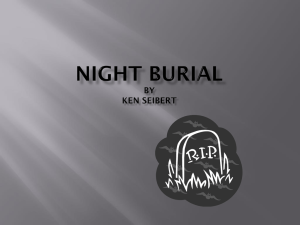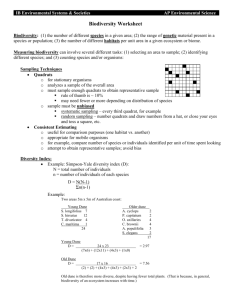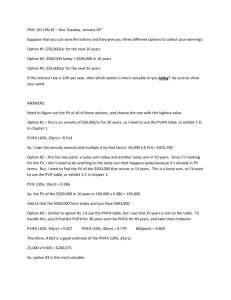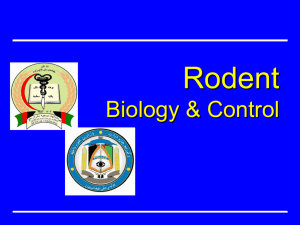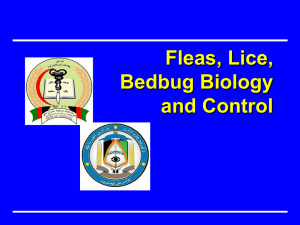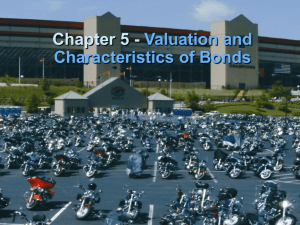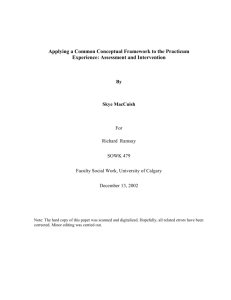ADMS3541 Fall 2014 Solutions of selected textbook questions(Chs
advertisement
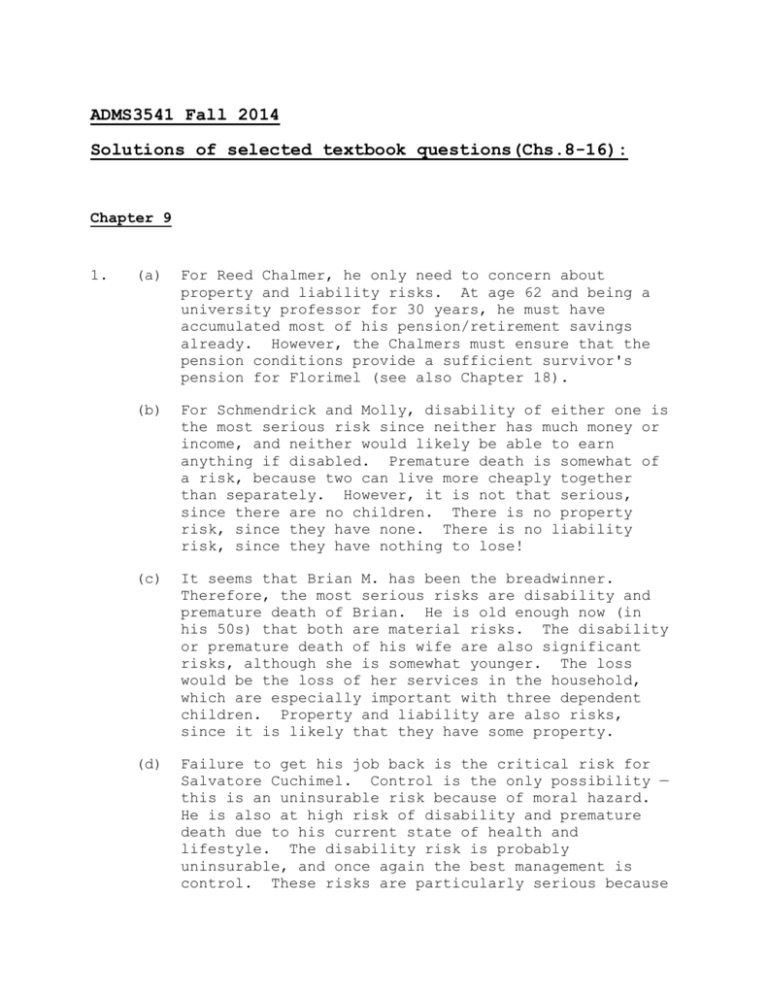
ADMS3541 Fall 2014
Solutions of selected textbook questions(Chs.8-16):
Chapter 9
1.
(a)
For Reed Chalmer, he only need to concern about
property and liability risks. At age 62 and being a
university professor for 30 years, he must have
accumulated most of his pension/retirement savings
already. However, the Chalmers must ensure that the
pension conditions provide a sufficient survivor's
pension for Florimel (see also Chapter 18).
(b)
For Schmendrick and Molly, disability of either one is
the most serious risk since neither has much money or
income, and neither would likely be able to earn
anything if disabled. Premature death is somewhat of
a risk, because two can live more cheaply together
than separately. However, it is not that serious,
since there are no children. There is no property
risk, since they have none. There is no liability
risk, since they have nothing to lose!
(c)
It seems that Brian M. has been the breadwinner.
Therefore, the most serious risks are disability and
premature death of Brian. He is old enough now (in
his 50s) that both are material risks. The disability
or premature death of his wife are also significant
risks, although she is somewhat younger. The loss
would be the loss of her services in the household,
which are especially important with three dependent
children. Property and liability are also risks,
since it is likely that they have some property.
(d)
Failure to get his job back is the critical risk for
Salvatore Cuchimel. Control is the only possibility —
this is an uninsurable risk because of moral hazard.
He is also at high risk of disability and premature
death due to his current state of health and
lifestyle. The disability risk is probably
uninsurable, and once again the best management is
control. These risks are particularly serious because
there is no other way for his child to receive
support, it seems. In case (c), for example, it would
be possible for the wife to start working if the
husband died or became disabled. The children would
grow up and leave home, becoming self-supporting.
Property loss is also an insupportable risk, because
he has no reserves. In this case, the main property
is the house.
Chapter 13
7.(a)
(b)
GDS = (PMT × 12 + $ 3,000)/$80,000
PMT = $1,750 per month
= 30%
TERM
RATE
AMRTZN.
E.M.R.
MONTHLY
MAX FIRST
IN YEARS
P.A.
IN YEARS
(M)
PMT
MORTGAGE
1
7.00%
25
0.575%
$1,750
$249,852
2
7.50%
25
0.615%
$1,750
$239,216
3
8.00%
25
0.656%
$1,750
$229,294
4
8.25%
25
0.676%
$1,750
$224,581
5
8.50%
25
0.696%
$1,750
$220,025
According to the 75% rule they only qualify for three
times their down payment of $ 50,000, therefore they
only qualify for a first mortgage of $ 150,000.
11.
Information of Mr. Maxi’s property is given as follows:
Projected price increase per month
Projected increase started
Frontage cost per foot
Space cost per foot ($1,000/100)
Air conditioning
Fireplace
Finished recreation room
2%
3 months
$2000
$10.00
$1,000
$5,000
$10,000
Problem 13.12: Adjustments for Direct Market Comparison
Subject
Property
Sale Price
Time Adjustment
Location
Lot size
House size
Washrooms
Garage
Air conditioning
Fireplace
Finished rec room
Modern kitchen
Walkout basement
Total Adjustments
Adjusted Sale Price
Now
Address
50'
2400
No
Yes
No
Sale #1
Sale #2
Sale #3
$222,000.00 $200,000.00 $250,000.00
0
12,241.6
0
0
1,000.00
-1,000.00
0
0
0
222,000.00
4000.00
2000.00
-10,000.00
-1,000.00
-1,000.00
-1,000.00
5,000.00
0
-10,000.00 -10,000.000
12,241.60
242,155.00
-22,000.00
239,000.00
Sale #2 is not the most recent sales, and it also requires
the most adjustments. Of the remaining two sales, #1 is as
recent as #3 but requires the least amount of adjustment.
Therefore, the estimated value of the subject property is
$222,000.
13.
Step 1: Estimation of land value: $870 × 46 =
Step 2: Reproduction cost new $78 × 2800
=
Step 3: Accrued depreciation:
Storm door
Window
Painting
Broadloom (39 × 200)
Total
350
900
4,600
7,800
13,650
Market Value by Cost Approach
$ +40,020
218,400
- 13,650
$244,770
Or round to $245,000.
Chapter 14
2.
Investment A:
E(r) = 8.15%
S.D. = 8.97%
Investment B:
E(r) = 9.50%
S.D. = 15.24%
These two investments cannot be ranked by the dominance
concept, because the higher expected rate of return also
has a higher standard deviation, or risk.
4.
(a)
Goal = FV (PV $26,000, N =32)
FV
PV
N
CPT
(b)
3,000,000
(= Goal)
26,000
(= Lottery Prize)
32
(= 65 – 33)
I/Y = 16% p.a.
Suppose he has a tax rate of 40%. Then, his required
before-tax return is .16/.6 = 26.7%. Investments
offering this rate of return are very scarce, and very
risky. This answer is anticipating Chapters 14-16 a
bit. The instructor might suggest that the students
look at Appendix D, where they will see that no
investment class comes close to this rate of return in
the long-run. Therefore, the practical answer is that
he needs to modify his goal or save more money.
Chapter 15
2. (a)
Assuming Semi-annual Coupons:
(i)
Price
CM
Face Value
Maturity
PV
PMT
FV
N
I/Y
YTM =
-9,500
475
10,000
40
5.04%
10.08%
(ii)
-10,500
512.50
10,000
60
4.87%
9.74%
(iii) YTM = 10% which should be obvious at once, since
the bond is trading at par.
(b)
No, for three reasons. The issuer may default on the
payments. The price of the bond changes as market
interest rates change (i.e., as the available
alternative opportunities change). If you sell any
time before maturity, you may receive a different
price than expected. Finally, you must reinvest the
coupons in an investment yielding exactly the same
rate of return. This is an underlying assumption of
the bond pricing mechanism — we also call this an
internal rate of return, because the funds are assumed
to be reinvested internally at the same rate.
6.
Joe’s savings account ($40,000), chequing account ($5,000), and
term deposit ($75,000) total to $120,000, of which only
$100,000 is covered. Therefore, he should consider
transferring at least $20,000 of these funds into another
CDIC member institute. His RRSP account is fully and
separately covered by CDIC.
Mary’s investment in chequing ($1,000), savings ($5,000),
and GICs ($100,000) total to $106,000, of which only
$100,000 is covered. Therefore, she should consider
transferring at least $6,000 of these funds into another
CDIC member institute. Her RRSP is invested in an
unqualified investment and therefore is not covered by
CDIC.
Each of their joint accounts is fully covered, since each
is qualified and under $60,000.
12.
(a)
(b)
=
EAR
=
(1.02564)365/181 -1
PB
=
30[PVIFA.035,20] + 1,000[PVIF.035,20]
[
(c)
100,000 − 97,500
HPR
1
(1.035)20
97,500
=
.02564
=
.0523789
1
1
=
30 × [0.035 − 0.035×(1.035)20 ] + 1000 ×
=
$928.94
]
PB(at end of year)
=
30[PVIFA.04,18] + 1,000{PVIF.04,18]
=
$873.41
HPR
=
=
=
=
Interest+P1 −P0
P0
60+873.41−928.94
928.94
4.47
928.94
$.0048 or 0.48%
Chapter 16
7.
(a)
E(rp) = x1E(r1) + x2E(r2) + x3E(r3) + .... + xnE(rn)
E(rp)
Sp2
Sp
(b)
= 12.89%
=
2 2
N
∑N
i=1 xi si + ∑ ∑i≠1 2xi xj rij si sj
= 14.20%
E(rp) ÷ Sp = 0.1289 ÷ 0.1421 = 0.91
Therefore, the probability of a negative return is
18.14%.
9.
THREE-YEAR INVESTMENT HORIZON
LOAD
FUND
FRONT
BACK
ANNUAL COSTS
FRONT LOAD BACK LOAD MANAGEMENT FEE
TOTAL ANNUAL COSTS
Dune
7.000% 0.000%
2.716%
0.000%
2.300%
5.016%
Middle Earth
0.000% 0.000%
0.000%
0.000%
4.000%
4.000%
Narnia
0.000% 9.000%
0.000%
2.772%
3.300%
6.072%
SIX-YEAR INVESTMENT HORIZON
LOAD
FUND
FRONT
BACK
ANNUAL COSTS
FRONT LOAD BACK LOAD MANAGEMENT FEE
TOTAL ANNUAL COSTS
Dune
7.000% 0.000%
1.514%
0.000%
2.300%
3.814%
Middle Earth
0.000% 0.000%
0.000%
0.000%
4.000%
4.000%
Narnia
0.000% 9.000%
0.000%
1.227%
3.300%
4.527%
TEN-YEAR INVESTMENT HORIZON
LOAD
FUND
FRONT
BACK
ANNUAL COSTS
FRONT LOAD BACK LOAD MANAGEMENT FEE
TOTAL ANNUAL COSTS
Dune
7.000% 0.000%
1.043%
0.000%
2.300%
3.343%
Middle Earth
0.000% 0.000%
0.000%
0.000%
4.000%
4.000%
Narnia
0.000% 9.000%
0.000%
0.621%
3.300%
3.921%
For a three-year investment horizon Middle Earth
would be the best alternative, and for six- and ten-year
horizons Dune would be the best alternative.
